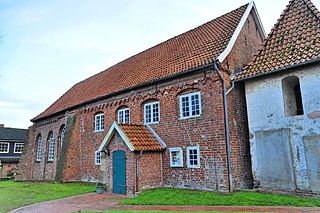
Johann Georg Wille, or Jean Georges Wille was a German-born copper engraver, who spent most of his life in France. He also worked as an art dealer.

Wilm Dedeke was a late gothic painter from Northern Germany. He was born in Lübeck.

Hinrik Bornemann was a Northern German Late Gothic painter. He was the son of Hans Bornemann, who died in 1474. After his father's death his mother was thrice remarried to painters- to Hinrik Funhof, to Absolon Stumme, and then finally to Wilm Dedeke. His main work was the Altarpiece of St. Luke (Lukas-Altar) for St. Mary's Cathedral in Hamburg, now shown in St. James the Greater Church. Upon his death in 1499 it was left unfinished, and was completed by Wilm Dedeke.

Hinrik Funhof was a late Gothic painter who lived and worked in Hamburg. After the death of his colleague Hans Bornemann in 1475, he took over Bornemann's studio and married his widow. When Funhof died ten years later, she remarried to another Hamburg painter, Absolon Stumme.

Saint Mary's Cathedral in Hamburg was the cathedral of the ancient Roman Catholic Archdiocese of Hamburg, which was merged in personal union with the Diocese of Bremen in 847, and later in real union to form the Archdiocese of Hamburg-Bremen, as of 1027.

Julius Alwin Franz Georg Andreas Ritter von Schlosser was an Austrian art historian and an important member of the Vienna School of Art History. According to Ernst Gombrich, he was "One of the most distinguished personalities of art history".

Girolamo Sartonio, also known as Hieronimo Sartorio and Geronimo Sartorio, was an innovative Italian architect and engineer who worked mainly the German cities of Hanover, Hamburg, Leipzig and Erfurt. His designs were based on Palladian architecture. He was a noted expert in the installation of stage equipment and theatrical machinery and also worked as a builder or consulting architect on the construction of various opera houses, such as the Oper am Gänsemarkt in Hamburg. He is also credited with the beginnings of opera in Leipzig and the construction of the opera house in Prague.
Willibald Sauerländer was a German art historian specializing in Medieval French sculpture. From 1970 to 1989, he was director of the prestigious Zentralinstitut für Kunstgeschichte, Munich.
Hans Jantzen was a German art historian who specialized in Medieval art.

The term Cologne School of Painting was first applied in the 19th century to describe old German paintings generally. It subsequently came to refer more specifically to painters who had their workshops in medieval Cologne and the lower-Rhine region from about 1300 to 1550.

The Neuenwalde Convent is a Lutheran damsels' convent in Neuenwalde, a locality of Geestland, Lower Saxony, Germany.

The Holy Cross Church is the church of the Neuenwalde Convent. Convent and Holy Cross Church are owned by the Bremian Knighthood, based in Stade. However, church and parsonage, are used per usufruct by the Lutheran Neuenwalde Congregation in Neuenwalde, a locality of Geestland, Lower Saxony, Germany. Besides the Holy Cross Church, only used, the congregation uses and owns the chapel in Hymendorf.
Herbert von Einem was a German art historian.
Hans Tietze was an Austrian art historian and member of the Vienna School of Art History.
Georg von Dadelsen was a German musicologist, who taught at the University of Hamburg and the University of Tübingen. He focused on Johann Sebastian Bach, his family and his environment, and the chronology of his works. As director of the Johann Sebastian Bach Institute in Göttingen, he influenced the Neue Bach-Ausgabe (NBA), the second complete edition of Bach's works.

Johann Wilhelm Schütze was a German painter and art professor. His birth year is sometimes given as 1814, and the place as Berlin. He has often been confused with Wilhelm Schütze, a painter from Munich.
Gustav Fock was a German music historian, editor early music and organologist. He is considered the most important Schnitger researcher of his time.

Johann Jacob Gensler was a German etcher and painter; specializing in genre scenes and landscapes.

Carl Gehrts, also Karl Gehrts, complete name Karl Heinrich Julius Gehrts was a German painter, illustrator and academic scholar. As a Professor, he taught at the Kunstakademie Düsseldorf.

August Ludwig Georg Meyn was a German portrait and genre painter.
This page is based on this
Wikipedia article Text is available under the
CC BY-SA 4.0 license; additional terms may apply.
Images, videos and audio are available under their respective licenses.














